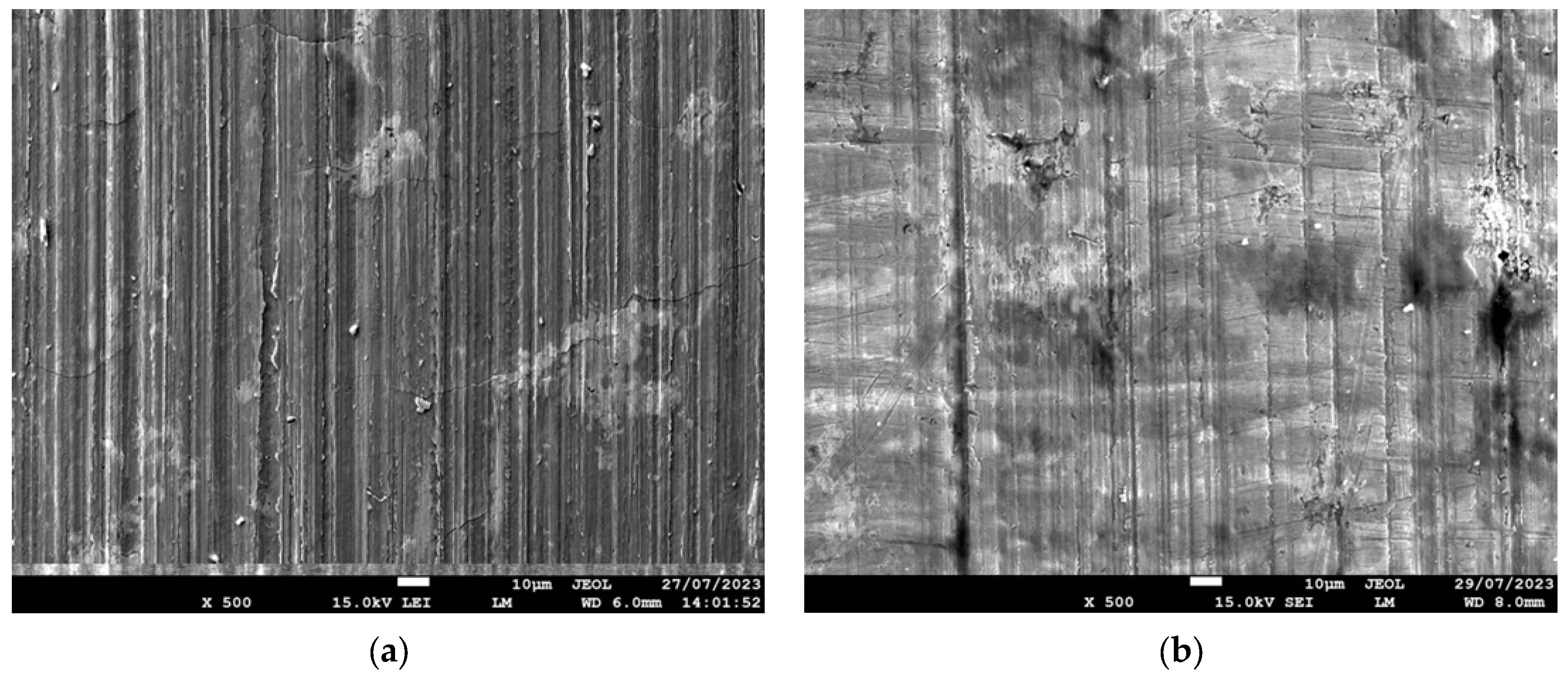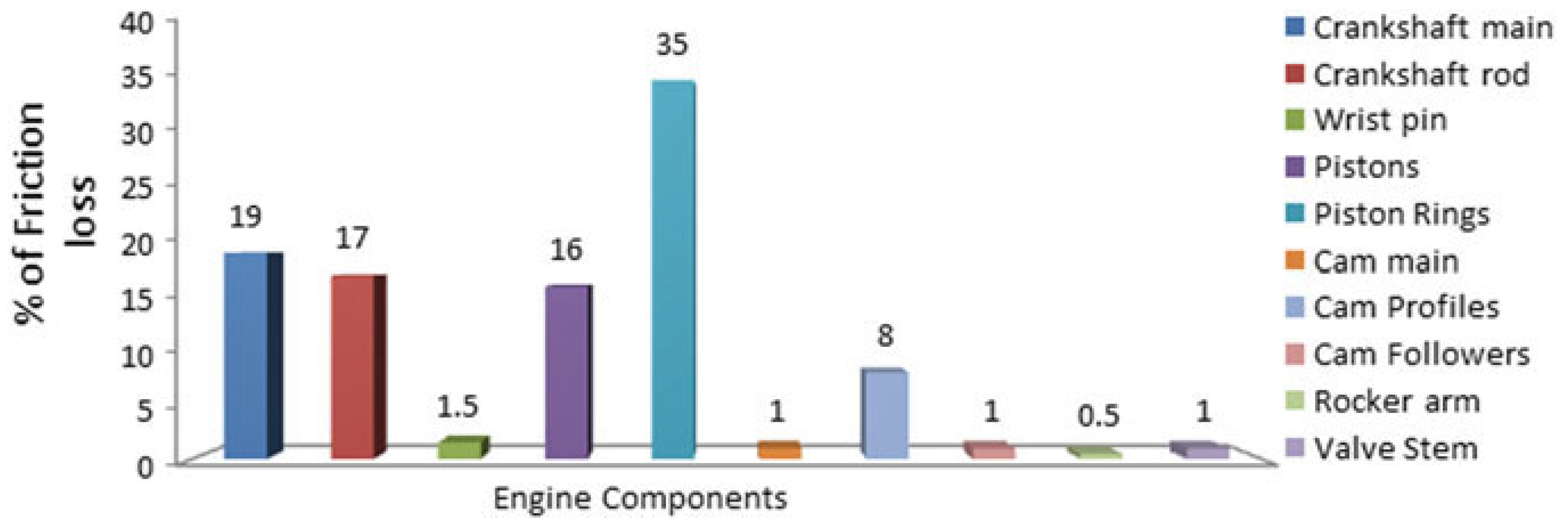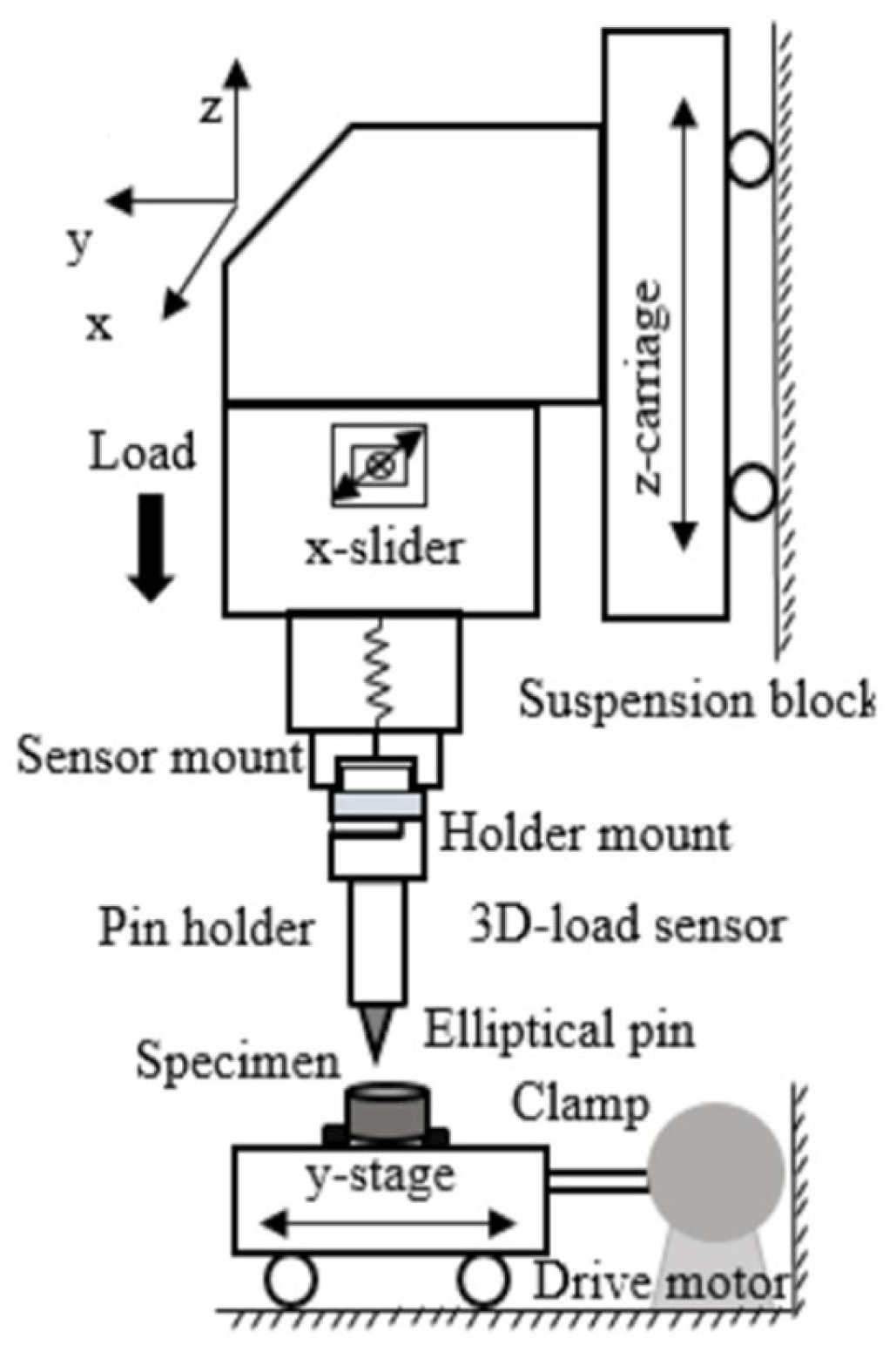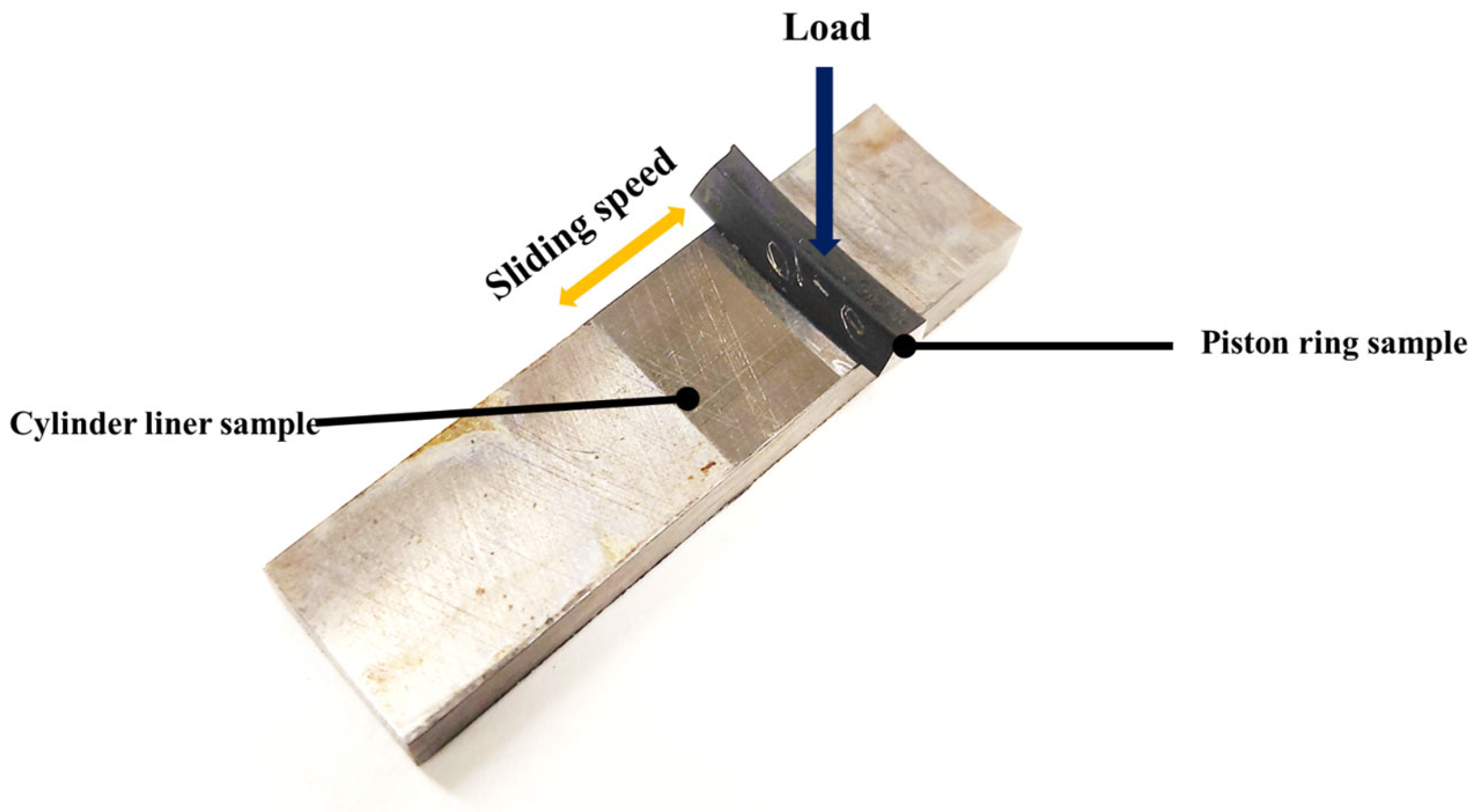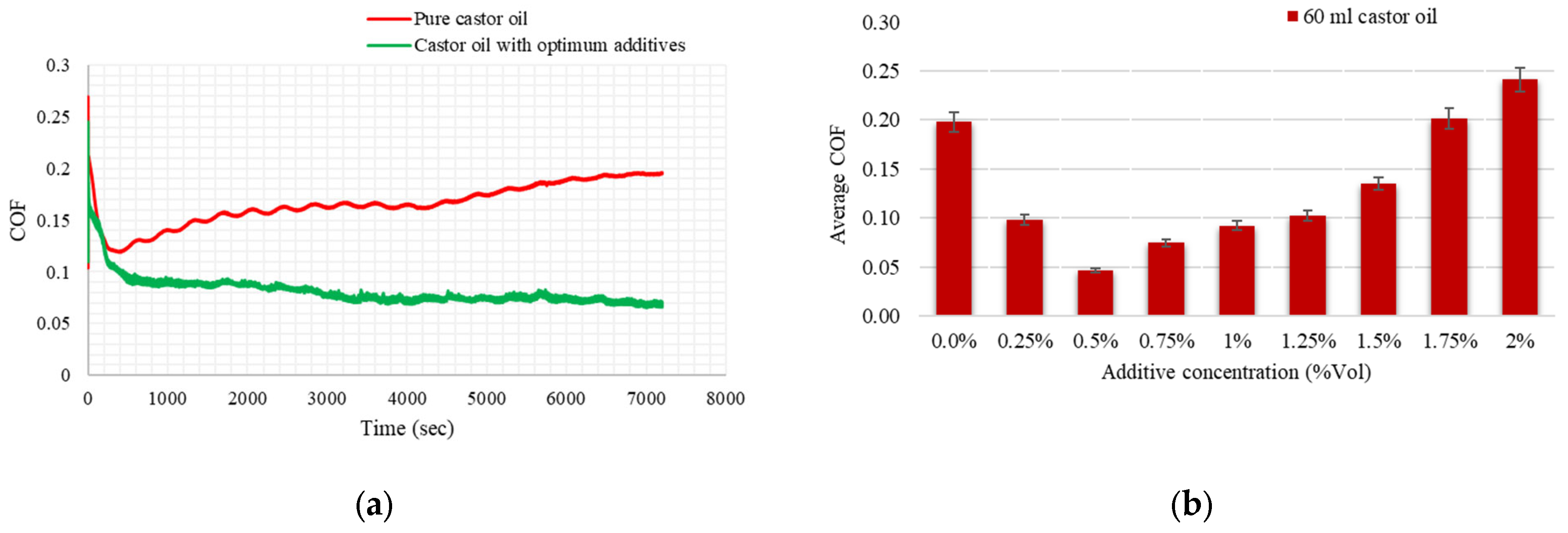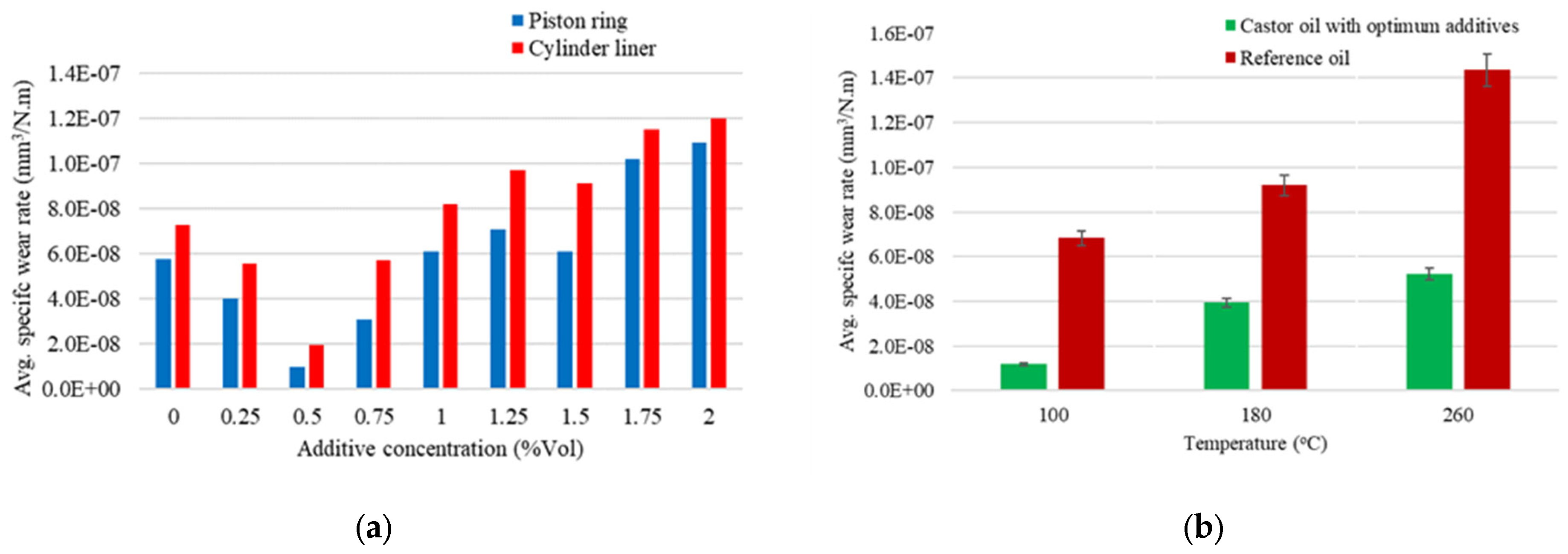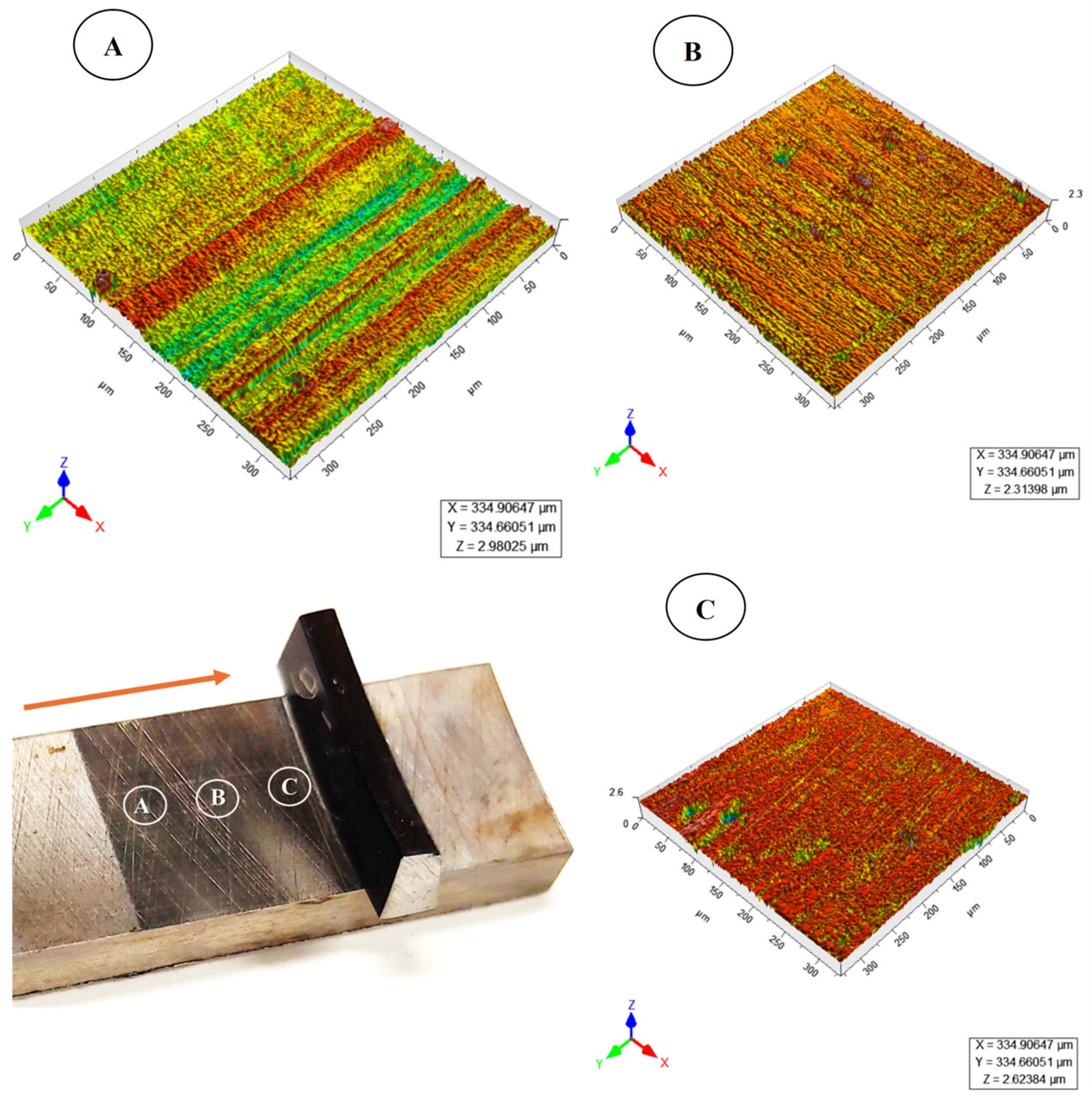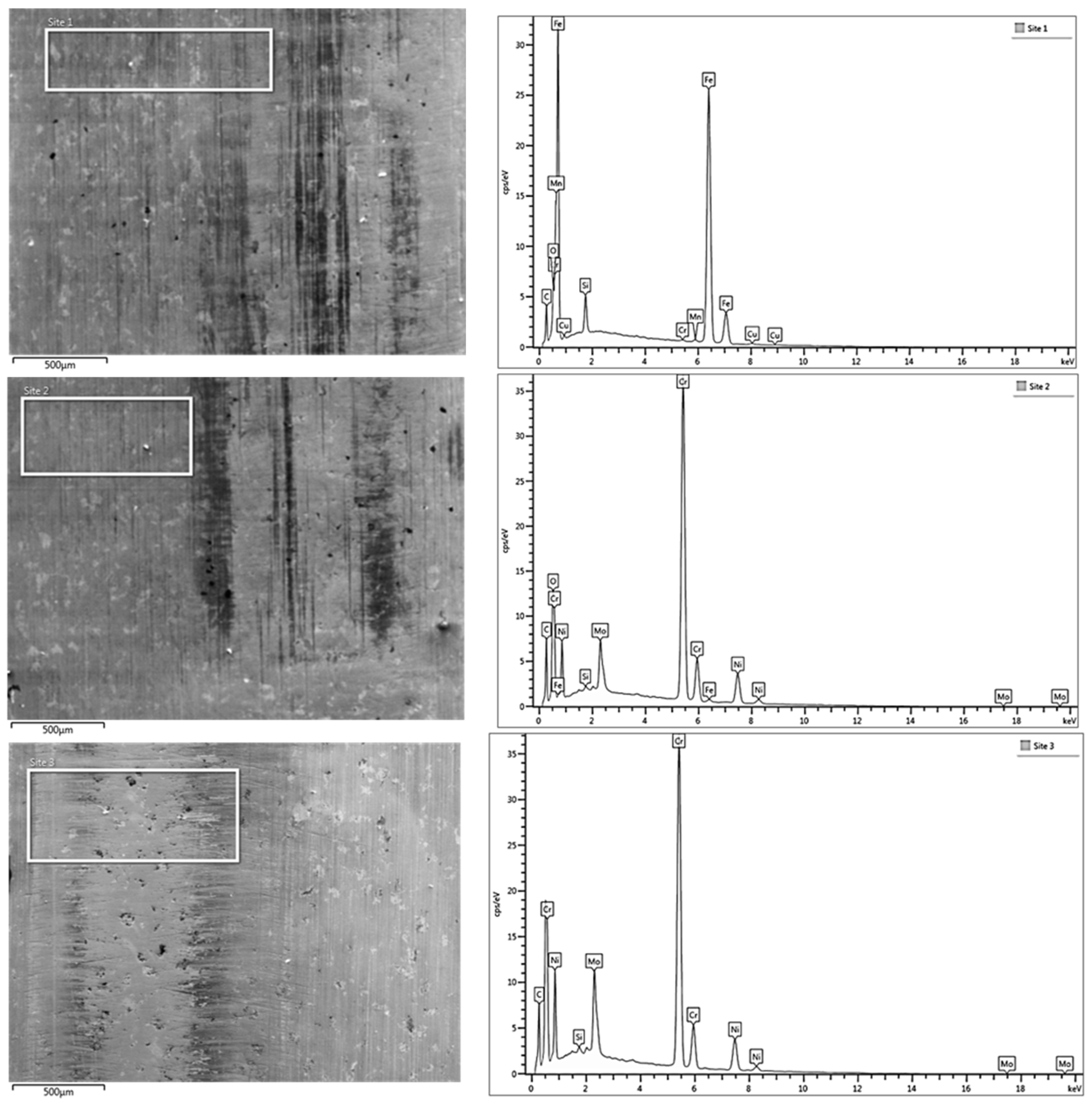1. Introduction
In the quest for more environmentally friendly, sustainable solutions to pollution caused by the automotive industry, the use of biolubricant oil in engine lubrication systems has gained attention, particularly in modern heavy-duty and agricultural machinery. Within the context of internal combustion (IC) engines, in which efficient lubrication is crucial for minimising friction, wear, and overall energy losses, researchers have increasingly focused on biolubricants to address both performance and environmental challenges.
Friction and wear [
1,
2,
3,
4,
5] are critical tribological factors that influence the performance and lifespan of IC engines. In an engine, various moving parts—such as pistons, piston rings, crankshafts, and camshafts—generate friction during operation due to the resistance encountered when two surfaces move against each other, as shown in
Figure 1. The contact between the top piston ring and the cylinder liner in IC engines is especially susceptible to friction and wear, which can lead to reduced engine efficiency and premature component failure. Wear refers to the progressive degradation of component surfaces due to friction and other factors. In IC engines, wear can lead to increased clearances, power loss, reduced fuel efficiency, and, in severe cases, catastrophic failures.
Proper lubrication [
7,
8,
9,
10,
11] in agricultural tractors and heavy-duty engines plays a crucial role in minimising friction and wear, ensuring smooth operation, reducing energy losses, and extending engine lifespan. The traditional reliance on petroleum-derived mineral-based lubricants from non-renewable fossil fuels has prompted a search for alternative lubricants that align with the principles of sustainability and reduced environmental impact.
Biolubricants [
12,
13,
14,
15,
16,
17,
18,
19,
20], derived primarily from renewable resources such as plant oils, promise lower carbon emissions, biodegradability, and reduced toxicity compared to their mineral counterparts. Their potential application in IC engines has gained interest not only for their environmental benefits but also for their ability to enhance engine efficiency and lifespan. Recent years have seen a growing interest in developing environmentally friendly and biodegradable lubricant oils such as coconut, sunflower, soybean, olive, castor, jatropha, rapeseed, jojoba, palm, pongamia, karanja, and rubber tree seed oils, all of which exhibit favourable tribological properties for machine lubrication [
21,
22,
23,
24,
25,
26,
27,
28,
29,
30,
31].
Among these, castor oil (Ricinus communis) [
32,
33,
34,
35,
36,
37,
38,
39], as shown in
Figure 2, has emerged as a strong candidate due to its distinct chemical composition and inherent lubricating characteristics. It has a high viscosity, strong film-forming ability, and resistance to thermal degradation, allowing it to perform well under the high-temperature conditions typical of IC engines. Castor oil contains a high concentration of ricinoleic acid, which enhances its lubricity and anti-wear behaviour. These properties make it a potential replacement for mineral oils in reducing friction and wear, with the added benefit of improving engine function and reducing environmental impact. In addition to its lubricating performance, castor oil offers oxidation resistance up to 250 °C, which can help extend engine life and reduce maintenance costs. Chemically, it consists of approximately 85–90% ricinoleic acid triglycerides, along with smaller amounts of linoleic, oleic, stearic, palmitic, linolenic, and trace long-chain fatty acids [
38].
However, incorporating castor oil into IC engines presents several challenges. Castor oil’s high viscosity can hinder cold-start performance by increasing friction and delaying the formation of a lubricating film. It also exhibits limited oxidative stability and a tendency to degrade under thermal stress, which can reduce lubricant lifespan and increase the risk of deposit formation. To overcome these challenges and fully realise its potential as a lubricant, precise formulation and careful additive selection are essential. Additives are crucial for enhancing castor oil’s performance, enabling customisation of its properties to suit engine lubrication requirements [
39]. Antioxidants such as phenolic and aminic compounds can slow oxidative degradation, while pour point depressants and viscosity index improvers enhance low-temperature flow characteristics. The compatibility of castor oil with additives also influences its performance. For example, castor oil may exhibit poor solubility with zinc dialkyldithiophosphates (ZDDPs), which are widely used anti-wear additives in conventional engine oils. This incompatibility can reduce the effectiveness of the additives and lead to inconsistent protection under boundary lubrication conditions [
40].
From an economic analysis point of view, recent data show that castor oil prices in Europe averaged USD 1585 to USD 1663 per metric tonne in late 2024, while mineral-based lubricants cost USD 1200 to USD 1500 per metric tonne. The global average price of castor oil currently ranges between USD 1.50 and USD 2.00 per litre, which is higher than that of conventional mineral oil lubricants, typically priced around USD 0.80–1.20 per litre [
41]. Though castor oil has a higher upfront cost, it may lower long-term expenses by extending engine life and reducing maintenance needs [
42]. Shifting to castor oil-based lubricants offers both environmental and economic benefits. Current price differences and technical challenges limit widespread use, but specific applications such as high-wear machinery or eco-sensitive areas already make practical sense. Advances in farming, chemical processing, and policy incentives could help castor oil become a mainstream lubricant within a few years. An EU-funded study under Horizon 2020 examined castor oil’s supply chain impacts. Researchers found that growing castor plants on less fertile land cuts greenhouse gas emissions more than traditional crops. Castor oil also breaks down naturally and poses fewer pollution risks. These qualities support the EU’s sustainability targets for industry and agriculture. The environmental advantages, paired with potential cost savings over time, position castor oil as a strong alternative to conventional lubricants [
43].
Despite extensive research into castor oil as a biolubricant, limited studies have investigated the influence of additive concentration, especially under the real-world operational conditions faced by agricultural engines. This study aims to fill that gap by examining the effect of varying concentrations of a binary additive mixture comprising propyl gallate (PG) and the ionic liquid 1-Ethyl-3-methylimidazolium tetrafluoroborate [HMIM(BF
4)] on the tribological performance of castor oil. PG serves as an antioxidant to enhance oxidative stability, while HMIM(BF
4) is selected for its friction-reducing and anti-wear properties [
44,
45,
46,
47].
Focusing on the critical piston ring–cylinder liner interface in IC engines, this study simulates real operational conditions using a Bruker UMT Tribo-lab in accordance with ASTM G181. The objective is to identify the optimal additive concentration that balances performance enhancement with formulation stability, thereby supporting the practical adoption of castor oil-based lubricants in agricultural tractors. The findings of this research work contribute to the development of eco-friendly lubricants for heavy-duty engines and advance the scientific understanding of additive–lubricant interactions in biobased formulations.
2. Materials and Methods
2.1. Sample Preparation
To prepare the test samples, the piston ring and cylinder liner sleeves from a 6195M model John Deere farm tractor engine were selected (see
Table 1 below) and cut to predetermined sizes. The cylinder liner is made of grey cast iron, while the piston ring is made of a chrome-plated steel alloy. The cylinder liner samples measure 12 mm by 45 mm, with a thickness of 4 mm, while that of the piston ring measures 4 mm by 16 mm, with a thickness of 2.9 mm. Proper care was taken during the cutting of both samples to prevent any heat damage that could potentially alter their original surface.
To minimise the influence of surface contamination on the tribological test results, a standardised cleaning protocol was followed for all test samples. This protocol ensured consistent and reliable pre-test surface conditions. Prior to the testing, samples were briefly wiped with laboratory-grade acetone or methyl alcohol to remove loosely adhering surface contaminants. Following this step, each sample underwent a five-minute ultrasonic bath in acetone at a controlled temperature of 50 °C. This stage effectively dislodged and removed tenacious dirt, debris, and impurities from the sample surface.
After the ultrasonic bath, samples were wiped with clean, lint-free laboratory soft tissues to eliminate any residual cleaning solvent that could interfere with the tribological tests. The cleaned samples were then subjected to a ten-minute drying process using warm air, maintained at a moderate, non-damaging temperature. Finally, the samples were placed in designated, clean sample bags for storage, preventing potential contamination during the interim period before testing.
2.2. Castor Oil and Additive Preparation
Both pure castor oil and the additives used in this research were purchased from Sigma-Aldrich [
44]. Propyl gallate (PG) and 1-Ethyl-3-methylimidazolium tetrafluoroborate (an ionic liquid) were used as additive agents with equal mixture rates. The physical properties of castor oil and the reference engine oil are shown in
Table 2 below. The ionic liquid, 1-Ethyl-3-methylimidazolium tetrafluoroborate [HMIM(BF)
4], is compatible with base castor oil. A lubricant–additive miscibility test was conducted to assess the miscibility of the additives with castor oil. Equal volumes of castor oil and each additive were combined and stirred at room temperature for 30 min. The mixtures were then observed for any signs of phase separation, turbidity, or precipitation over a 72 h period. Both PG and HMIM(BF)
4 remained fully miscible with castor oil, exhibiting no visual signs of incompatibility. These additives’ compatibility with castor oil can be attributed to their chemical structures [
49]. PG, an ester of gallic acid, possesses hydroxyl groups that can form hydrogen bonds with the hydroxyl groups present in ricinoleic acid, the primary component of castor oil. This interaction enhances the solubility and stability of PG in castor oil. HMIM(BF)
4, an ionic liquid, consists of an imidazolium cation and a tetrafluoroborate anion. Its amphiphilic nature allows it to interact with both the polar and non-polar components of castor oil. The imidazolium cation can engage in π-π interactions with the unsaturated bonds in ricinoleic acid, while the tetrafluoroborate anion can interact with the hydroxyl groups, promoting miscibility [
50,
51].
The reference oil used in this experimental study is PLUS-50 II PREMIUM engine oil, specifically designed to excel in modern, low-emission engines while meeting the rigorous requirements of heavy-duty off-road applications. This well-established reference oil served as a robust benchmark for evaluating the effectiveness of the castor oil–additive formulations [
48].
Table 2 compares key physical properties of castor oil and the mineral-based engine oil, PLUS-50 II PREMIUM. Castor oil has a higher viscosity at 40 °C and 100 °C, enhancing film formation and potentially reducing friction and wear. Its greater density may influence flow and atomisation in high-speed engines, while its superior thermal conductivity supports better heat dissipation. However, castor oil has a lower flash point and pour point, indicating challenges in high-temperature stability and cold starts, as well as a lower Total Base Number (TBN), which limits its ability to neutralise combustion acids. In contrast, PLUS-50 II PREMIUM offers a higher TBN and better thermal stability, making it ideal for low-emission, high-load conditions. These differences are crucial for assessing the performance of castor oil with additives, which must enhance oxidative and thermal resilience while taking advantage of its viscosity and thermal properties.
To validate the effectiveness of the formulated castor oil lubricant, its tribological performance (friction, wear) at the optimal additive concentration will be directly compared with that of the standard mineral oil lubricant, Plus-50 II 15W-40 premium engine oil, which is typically used in John Deere farm tractor engines. This comparison will ensure the relevance and applicability of the test results to real-world agricultural machinery.
2.3. Tribological Experimental Setup
To investigate the tribological behaviour of the top piston ring–cylinder liner contact conditions, the Bruker UMT Tribolab test rig was employed (see
Figure 3 below). It is equipped with high-precision force sensors. One sensor typically measures the normal force (Fz) applied perpendicular to the contacting surfaces, pressing the piston ring sample against the cylinder liner. During the test, the tribometer applies a controlled load through the normal force sensor. Another sensor, often a torque sensor (Tx), measures the frictional force (Fx) that arises due to this contact and resists the movement of the ring sample.
The Bruker UMT software (version 2.22.112) likely calculates the coefficient of friction (COF), which is the ratio between the frictional force (Fx) and the normal force (Fz), in real time during the experiment. The software associated with the Bruker UMT Tribolab continuously records different data from the force sensors throughout the test, including the normal force (Fz), the frictional force (Fx), speed, stroke length, temperature, and potentially other parameters. The normal force and friction force sensors have a resolution of ±0.5% of the full-scale output, and the torque sensor provides a repeatability of ±0.2%. The system’s sampling rate and filtering algorithms minimise noise and enhance measurement fidelity. Based on repeated calibration checks, the overall measurement uncertainty remains within ±1% for both normal and tangential forces under standard test conditions. These specifications ensure the consistent and reliable acquisition of tribological data.
After the test, the software can be used to analyse the collected COF data. This analysis may involve plotting the COF as a function of time, test parameters, or other variables. The data help to understand how factors such as load, sliding velocity, temperature, and lubricant formulation affect the friction between the contacting surfaces.
2.4. Tribological Test Configuration
The test replicates the actual tribological contact between top piston rings and cylinder liners. The test configuration involves a stationary cylinder liner sample and a reciprocating ring sample, which is held by the upper carriage of the tribometer. In this case, the test configuration will feature a stationary ring and a reciprocating, sliding cylinder liner. The basic principle of measuring COF using force sensors remains unchanged. The test configuration is shown in
Figure 4. A pure sliding reciprocating (ring on liner segments) configuration mode is used to provide better testing fidelity.
To ensure reliable test results, particular attention was given to the alignment between the ring and liner samples at their mounted contact position in the Bruker UMT Tribolab test rig. Any misalignment between the ring and liner during testing could lead to inaccurate data. This involved using Fujifilm Prescale pressure-sensitive foil to detect and rectify any misalignment issues before commencing the experiment. This ensured that the contacting surfaces were precisely aligned, replicating realistic tribological conditions within the engine and providing reliable measurements of friction and wear.
2.5. Test Strategy and Control
Throughout this experimental study, the test conditions, such as variations in load, sliding speed, temperature, additive concentration, and test duration, were thoroughly regulated and maintained. These conditions replicate the working conditions of actual John Deere agricultural tractor engines in the field. The sensors, thermocouples, and other measurement equipment attached to the Bruker UMT Tribolab test rig enabled the real-time monitoring of the test conditions and their gradual changes during the entire test period. This included observing and analysing the behaviour of the ring–liner contact under different conditions, as well as making adjustments based on the machine’s output.
The contact pressure between the top compression piston ring and cylinder liner was estimated to be 17 MPa, based on sources in the literature on HDD engines. For this study, an average contact pressure of 7 MPa was chosen, approximately matching the analytical calculation of Hertzian contact pressure between the ideal piston ring and cylinder liner. The impact of varying loads on friction and wear at the contact interface was first investigated, and the load that best replicated real engine conditions was chosen as the constant load applied by the top compression piston ring to the cylinder liner—185 N.
The system was heated to a temperature of 250 °C with a 5 °C temperature ramp, while a motion frequency of 10 Hz was applied to ensure uniform lubrication and heating. The engine frequency, calculated from the actual engine speed at full load (2100 RPM or 35 Hz), was reduced to 10 Hz during the test to maintain uniform lubrication and minimise vibrations in the Bruker UMT test rig. A temperature of 100 °C was selected at the start because it corresponds to the point at which the viscosities of castor oil and the reference oil are approximately equivalent. Temperatures of 180 °C (the maximum near TDC during engine operation) and 140 °C (the average of these two temperatures) were also tested to assess performance under varying thermal conditions.
The stroke length was set to 10 mm purely to ensure a sufficient edge effect on the sample material and to provide optimal reciprocating motion during the tests. The test duration for each experiment was set to two hours (7200 s), allowing for the formation of wear scars with an adequate profilometric resolution. The sliding length was calculated as the product of time, frequency, and distance in one cycle (7200 s × 10 Hz × 20 mm), resulting in a total sliding distance of 1,440,000 mm (1440 m).
Additive concentrations were assumed to range between 0% and 2% in volume. Subsequently, the ranges were refined to identify the most effective and acceptable concentration based on reductions in the coefficient of friction (COF) and wear scar diameter.
Table 3 compares the laboratory test conditions with those in real engine operation to highlight the simplifications involved in the experimental setup. While the lab tests provide controlled and repeatable measurements, they represent an idealised scenario that excludes certain complexities present in real engine environments. For example, the lab used castor oil in an oil bath under lower pressure and speed, whereas real engines experience fluctuating pressure, deficient lubrication due to the scraper ring, and higher sliding velocities. These differences can influence friction, wear, and lubricant degradation rates. The simplified contact geometry and stroke length in the lab also reduce thermal and mechanical stresses, potentially underestimating the severity of wear or the breakdown of additives under actual operating conditions. Therefore, while the lab results offer useful trends and comparative insights, they may not fully capture the dynamic interactions and degradation mechanisms occurring in a running engine. Extrapolating from lab-scale tests assumes that friction and wear behaviours scale linearly with contact pressure, velocity, and temperature. In practice, this is rarely the case. Higher sliding speeds and more severe thermal gradients in engines can accelerate oil oxidation, influence boundary film formation, and increase the rate of material degradation. Similarly, the reduced stroke and frequency in the lab setup result in different lubrication regimes and contact durations, which may not reflect the transient tribological events present in engine cycles. Another limitation lies in lubricant replenishment. The lab maintains a fixed oil volume and composition, whereas engine oil undergoes continuous shear, contamination, and chemical transformation. These dynamic effects influence viscosity, film strength, and additive performance, which the lab test does not replicate.
2.6. Data Measurement and Analysis
COF and frictional forces were accurately measured at the piston ring–cylinder liner contact using suitable sensors, such as a load cell or friction force transducer connected to the Bruker UMT Tribolab test rig. Gravimetric wear was evaluated by weighing the samples before and after testing using an OHAUS Pioneer Precision Balance with a readability of 0.001 g. The wear data obtained for different additive concentrations were statistically analysed to determine the effect of additive concentration on wear performance. Data on COF, wear rates, and wear volume for each sample, obtained through triplicate testing (three test repetitions), were statistically analysed to draw meaningful conclusions.
3. Results
3.1. Friction Performance
At the beginning of the experimental study, an extensive series of tests was conducted to evaluate the friction and wear properties of pure castor oil without any additives, at elevated temperatures up to 350 °C—the decomposition temperature of pure castor oil. The results showed that pure castor oil loses its lubrication capacity throughout the entire operation time, which leads to an increase in COF, see
Figure 5a. The COF for pure castor oil increases at higher temperatures, indicating lubrication failure. This behaviour likely results from oxidative degradation, which breaks down the triglyceride structure of castor oil, forming polar compounds that reduce lubricity. Elevated temperatures also reduce viscosity, which impairs the formation of a stable lubricating film and increases metal-to-metal contact. Subsequently, a series of additional tests was carried out by adding various concentrations of selected additives. First, both lubrication conditions show a high coefficient of friction (COF), but this decreases rapidly within the first few hundred seconds. This behaviour is typical, as surface interactions stabilise, and the lubricant forms a stable film. These tests aimed to investigate the impact of these additives on reducing friction and enhancing the oil’s wear resistance capacity, ultimately leading to improved engine efficiency.
After conducting the experimental tests, it has been determined that the most effective concentration of additive for a volume of castor oil in the top compression ring–cylinder liner contacts is 0.5% volume, where the minimum COF and wear rate were obtained. This concentration has been proven to reduce COF and provide notable benefits. Referring to
Figure 5b, it is evident that the average COF experiences a decrease from 0.2 to 0.05 as the additive concentration level increases from 0% to 0.5% in volume. However, as the additive concentration increases from 0.75% to 2% in volume, the average COF begins to increase from 0.07 to 0.24.
This showed that as the temperature of the castor oil rises from 100 °C to 260 °C, the average COF between the top piston ring and cylinder liner also increases, as shown in
Figure 6a. This situation occurred due to the reduction in viscosity of the castor oil when it heats up because its molecules move more freely, which results in a decrease in its viscosity. As a result, the castor oil becomes less effective in reducing friction between the top compression piston ring and cylinder liner contact, causing the COF to rise at more elevated temperatures,
Figure 6b.
The additives in castor oil work in a variety of ways, such as improving the properties of the existing base oil, suppressing unwanted properties, and introducing new features to it. For this purpose, the mixture of propyl gallate and HMIMBF4 (ionic liquid) is blended as additives to a base castor oil to increase its viscosity, minimise friction, control corrosion, and improve wear resistance, which eventually leads to an increase in the life of the engine.
It is important to note that excessive amounts of additive content can result in higher COF and high wear debris. Two main drawbacks are found in using higher additive concentrations. The first one is the premature depletion of excessive additives, which leaves the formulated castor oil with insufficient protection over time. The second one is negative impacts on lubrication by increasing the formulated castor oil’s viscosity, which hinders its flow in an engine or even introduces unintended negative effects on its properties. Therefore, identifying the optimal concentration through experimentation is crucial.
3.2. Wear Performance
Gravimetric analysis, Taylor Hobson, and SurfaScan profilometry techniques were used to quantify the wear characteristics of castor oil and the reference engine oil. The two profilometry techniques provided detailed surface profile measurements of the top compression piston ring and cylinder liner surfaces, which allows for a precise evaluation of wear depth and area.
As previously mentioned, weight measurements taken before and after testing, facilitated by the high-precision balance, provided quantitative data on wear loss (and wear rate). The effect of additive concentration on the wear performance of castor oil is illustrated in
Figure 7a, where the average specific wear rate is shown for both the top compression piston ring and the cylinder liner. A distinct trend is observed, wherein the average specific wear rate decreases with increasing additive concentration, reaching its lowest point at approximately 0.5% volume. Beyond this concentration, wear begins to rise again, indicating that an excess of additives may lead to diminishing protective effects, possibly due to additive saturation or film instability. Meanwhile,
Figure 7b presents the variation in average specific wear rate with temperature, comparing castor oil with optimised additives to the reference oil. Notably, castor oil with optimum additives consistently demonstrates superior wear resistance, particularly at elevated temperatures, reinforcing its potential as a sustainable alternative in engine lubrication.
Gravimetric wear analysis shows that the cylinder liner samples consistently lost weight, while the corresponding piston ring samples gained weight. This pattern suggests a directional material transfer from the liner to the ring. The increase in ring mass, coupled with the reduction in liner mass, indicates an adhesive wear mechanism. Material from the liner surface may have adhered to the ring and been pulled out as the ring continued its reciprocating motion. This stick–slip behaviour and transfer of adhered fragments align with typical characteristics of adhesive wear, whereby material removal from one surface results in accumulation on the mating surface.
Table 4.
Selected gravimetric analysis results.
Table 4.
Selected gravimetric analysis results.
| Test ID | Piston Ring Weight
Change (g) | Cylinder Liner Weight Change (g) |
|---|
| O1-1-1 | 0.003 | −0.007 |
| O1-1-2 | 0.0014 | −0.018 |
| O1-1-3 | 0.061 | −0.073 |
| O1-1 | 0.001 | −0.003 |
| O1-2 | 0.006 | −0.008 |
| O1-3 | 0.001 | −0.002 |
| O1-4 | 0.007 | −0.010 |
| O1-5 | 0.012 | −0.014 |
The analysis of surface roughness plays a crucial role in estimating the wear of the top compression piston ring and cylinder liner. Once the surface profile data are obtained with Taylor Hobson Profilometry, specific roughness parameters such as average roughness (Ra) and root mean square roughness (Rq) are automatically calculated to quantify the surface texture. Ra represents the average deviation of the surface profile from the mean line, with a higher Ra value indicating a rougher surface. Rq, being similar to Ra, gives more weight to larger deviations, providing a more sensitive measure of peak and valley features.
The overall wear depth is then calculated by determining the difference between the average roughness (Ra or Rq) values before and after the test. The volume of material removed due to wear can be estimated by integrating the surface profile data (obtained from profilometry) over the defined wear track area. The image clearly shows remarkable cracks and wear debris, which highlight key wear mechanisms. Finally, as depicted in
Figure 8, the calculated surface roughness measurements of top compression piston rings and cylinder liners, taken before and after tribological testing, serve as a crucial tool for wear estimation using MountainsMap software (version 10, used with permission) [
53].
3.3. Worn Surface Analysis
Scanning Electron Microscopy (SEM) offers high-resolution images of the worn contact surfaces, allowing for a visual assessment of wear/tear features and surface texture on the piston ring and cylinder liner contact surface. Accordingly, the visual examination of the wear patterns on the test ring samples further exposed the impact of additive concentration on wear resistance. In the first place, higher additive concentrations led to improved wear resistance, suggesting the effectiveness of the additives in protecting the surfaces. However, this trend did not continue indefinitely. Beyond a certain optimal concentration, further addition of additives did not provide additional wear protection benefits. This observation again underscores the critical importance of finding the optimal balance of additive concentration to maintain wear resistance for maximising the lifespan and performance of the engine.
Figure 9.
The SEM image of the worn surface of the top compression ring: (a) Castor oil with optimum additives. (b) The reference engine oil after the test.
Figure 9.
The SEM image of the worn surface of the top compression ring: (a) Castor oil with optimum additives. (b) The reference engine oil after the test.
A visibly smaller amount of wear debris was found in the castor oil-lubricated ring surfaces when compared to that of the reference engine oil. Meanwhile, a few noticeable cracks and microcracks were observed in the contact surface ring lubricated with biodegradable castor oil. The wear track of the biodegradable oil-based lubricant was smoother compared with that of the reference oil lubricant. It was found that the contact surfaces lubricated with castor oil had a higher amount of corrosive wear compared to the reference engine oil-lubricated surface. This was mostly due to oxidative or chemical wear, and it appeared as a black spot on the lubricated surfaces of the sample. On the other hand, lower wear volume was observed in the biodegradable castor oil-lubricated surface as compared to the reference engine oil.
Finally, it was found in the experiment that the top compression ring and cylinder liner surfaces experience various types of wear, such as adhesion, abrasion, corrosion, and fatigue wear. High levels of sticking (adhesive wear) and scraping (abrasive wear) between the surfaces were observed due to the oil layer not being thick enough, causing direct contact between the ring and liner surface. The high temperature in the contact area also worsened this situation by creating a substance that damages the oil film (peroxide), potentially leading to some corrosion. The wear patterns seen around here suggest that the oil film was too thin to fully prevent contact between the ring and liner (boundary lubrication), which explains the dominance of adhesive and abrasive wear with minimal signs of other wear types.
3.4. EDX Analysis
Energy-dispersive X-ray (EDX) analysis was employed to investigate the elemental composition of the top compression piston ring and cylinder liner samples following the tribological tests to achieve the best understanding of the material transfer and wear mechanisms. Accordingly, the presence of several key elements such as Chromium (Cr) and Carbon (C) was detected on all lubricated surfaces of the top compression piston ring, which indicates some transfer from piston ring material to the cylinder liner during the test, likely due to contact under high pressure at elevated temperature.
Iron (Fe), Fluorine (F), and Carbon (C) elements, originating from the cylinder liner material, appeared across all lubricated surfaces. Oxygen (O) was also detected on the surfaces lubricated with castor oil. This presence results from oxidation reactions of the castor oil during operation. The high temperature and mechanical stress in the contact zone can promote the oxidative degradation of castor oil, leading to the formation of oxygen-containing compounds that adhere to the surface. Anti-wear elements such as F, P, Ca, and S were identified on the top compression piston ring surface lubricated with castor oil. Their presence is indicative of the anti-wear additives incorporated into the lubricant formulation, potentially contributing to wear protection, as shown in
Figure 10. When the samples were lubricated with the biolubricant castor oil, the overall amount of wear debris elements (Fe, C, Cr, and Si) was lower compared to other reference engine-lubricated samples. This suggests that the formulated castor oil lubricant may have helped minimise wear on both contacting surfaces.
The EDX analysis showed an understanding of how engine lubricants interact with the top piston ring and cylinder surfaces they come in contact with. The observation of anti-wear elements, along with the possibility of a decrease in wear debris with the use of a castor oil-based formulation, is quite promising, indicating its potential for exceptional tribological performance in the IC engine.
4. Conclusions
This experimental study investigated the impact of additive concentration on the tribological (friction and wear) performance of castor oil as a base lubricant candidate for piston ring–cylinder liner contacts of John Deere agricultural tractors under elevated temperatures. A special focus was given to the top piston ring (compression ring) because it operates in an area with a limited oil supply. This will create a starved oil region, making it particularly susceptible to a high COF and wear rate. Moreover, the top piston ring experiences the highest level of COF among all engine parts due to direct contact with the cylinder wall, sealing the combustion chamber, and preventing gas leakage. The combination of limited lubrication and high friction makes this ring a critical component to study tribologically to ensure engine performance and longevity.
In such cases, however, it has been proved experimentally that castor oil alone as a base lubricant is insufficient to provide total friction and wear protection in an IC engine for prolonged hours of operation under high contact pressure and temperature conditions encountered at the cylinder–piston ring interface, particularly near the engine’s top dead centre (TDC) due to the influence of fuel combustion. Therefore, to improve the engine lubrication effectiveness, castor oil is formulated with compatible additives that produce a protective film at contact surfaces.
The addition of a 0.5% volume of a mixture containing propyl gallate and ionic liquid (1-Hexyl-3-methylimidazolium tetrafluoroborate) improved the castor oil’s tribological (friction and wear) performance. The results of the experimental work also showed that there is a clear direct correlation between the concentration of additives and the tribological performance of the castor oil. Lower concentrations of additives were found to improve certain factors, such as reducing friction and wear. However, higher concentrations of additives led to high average COF and wear and had negative effects.
According to the evidence from the results of the experimental work, propyl gallate and ionic liquid work together to enhance the tribological properties of castor oil, making it a promising lubricant candidate in agricultural tractor engines. The substantial decrease in both average COF and wear rate compared to the reference oil proved that castor oil could be an excellent option for agricultural tractor lubrication.
Generally,
Compared to the reference engine oil, the castor oil with 0.5% volume additives exhibited a remarkable reduction in the average coefficient of friction (COF) by approximately 34.8% at a contact pressure of 7 MPa. This indicates a substantial improvement in the lubricating ability of castor oil, leading to less energy loss due to friction between the top compression ring and cylinder liner contact surfaces.
The combination of propyl gallate and ionic liquid additives demonstrated a dominant positive impact on wear reduction. The wear track on the ring and liner surface lubricated with castor oil was smoother compared to the reference engine oil, indicating potentially lower wear rates. This result was further supported by the finding of lower wear volume in the castor oil-lubricated ring and liner surfaces, suggesting the formation of a more effective tribo-film on the contacting surfaces, which minimises wear and tear under severe operating conditions.
An analysis of worn surfaces using SEM and EDX revealed a difference in tribo-film quality. Pure castor oil resulted in a rough film with cracks and signs of failure at elevated temperatures. In contrast, the addition of 0.5% volume additives led to a slightly improved reaction film, creating a stronger and more protective layer.
5. The Significance and Potential of the Present Work
In this study, we evaluated castor oil blended with propyl gallate and the ionic liquid 1-ethyl-3-methylimidazolium tetrafluoroborate at a tractor engine’s piston ring–cylinder liner interface. The Bruker UMT TriboLab tribometer under ASTM G181 conditions was used to mimic real engine load, temperature, and speed conditions. We then identified the additive blend that delivers the lowest friction, reduces wear, and keeps the oil stable during engine operation. We also showed how the antioxidant and the ionic liquid form a protective film and slow oxidation. We confirmed that the blend of castor oil with the two additives remained stable during prolonged testing. Our results show a clear path to cutting engine maintenance, extending component life, and lowering emissions.
This study provides the first evaluation of this propyl gallate–ionic liquid pair under ASTM G181 and offers a clear formulation path for heavy-duty applications. In this regard, the detailed tribological performance evaluation of castor oil with the two additives is expected to contribute significantly by generating new knowledge about the selection and further evaluation of this biolubricant.
6. Limitations and Scope for Future Work
Using repeatability pattern triplication during testing ensures the reliability of the test data, taking into account the influence of variations in surface roughness, lubricant contamination during testing, or inconsistencies, if any, in the preparation of additive mixtures. Despite clear improvements observed under the testing conditions, this study was conducted under the specific engine selected at full load conditions. Furthermore, long-term engine durability, including environmental exposure resistance and deposit formation, needs to be evaluated. Testing of the additive–lubricant formulation under a broader range of temperatures, pressures, and engine types—in addition to the long-duration performance of the formulation, the chemical stability of the additive film, and the environmental impacts of the additives—will help determine real-world feasibility. Moreover, a cost analysis of castor oil’s life cycle, including production, processing, additive blending, and engine maintenance, is recommended for future work.
